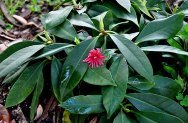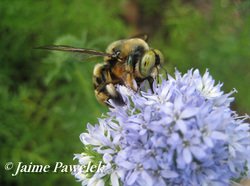Landscape Styles
Xeriscaping
In landscaping, the word xeriscape has become a catch all term for sparse planting of arid desert plants among vast expanses of rock with the purpose of eliminating costs associated with irrigation and maintenance. However, this term is improperly applied in Florida landscape conditions. Central and South Florida are sub-tropical and tropical respectively, not arid. While some xeric or arid plant material can survive in our climate, most are ill suited for our humidity and rainfall.
I have made 'Florida specific' adaptations to this style, on the left you see a backyard garden in this style that combines many elements suitable to Orlando Florida landscapes...
Florida Native Landscaping
Native landscapes consist of plant material that exists naturally in Florida's ecosystems. These plants survive in the wild without any inputs from humans so naturally, many people think they will do the same in a residential landscape setting. This is a common misconception. The neighborhood landscape is not like the wild environment these plants are accustomed to. And the aesthetic appearance of these plants in a wild setting may not be what a homeowner expects to occur in his landscape.
Don’t get me wrong, I encourage the use of native plants when it makes sense. But it’s not automatic if it’s native. Some native plants and arrangements based on them may require an unexpected measure of care to thrive in the landscape. This would include supplemental irrigation, trimming, weed control, mulch, and even fertilization. This is why I employ Florida friendly landscape principles to my designs…
Florida Friendly Landscaping
Florida friendly landscapes are an extension of the native landscape style. This style includes not only native plants but also plants non-native plants that are non-invasive. Non-invasive non-native plants are those that do not propagate profusely, spread into wild areas, and displace native plant material and by extension wildlife.
By utilizing this category of landscape design, your plant material selection greatly expands. Many of these plants are super tough and provide much needed contrast in landscapes that must meet the needs of contemporary neighborhood landscape expectations.
By selecting the best plants for your property conditions, Florida friendly landscaping can be an enjoyable low-maintenance option to traditional landscaping. Imagine more flowers and butterflies!
Contemporary and Turf Grass Dominant Landscapes
Of all the styles, probably the most recognizable is the formal design that we currently see in most neighborhoods. These designs are turf dominant, have rows or masses of clippered hedges or shrubs in layers, and accents or focal points at strategic locations. Most folks think these landscapes are very attractive. Most often they consist of St. Augustine, require regular intervals of mowing, irrigation, fertilization, pest and disease control. When properly maintained they do look neat and well maintained.
I can design in this style if you prefer. However, after working with me through the design and consultation process you may learn that you have other options.
Wildlife Landscaping Central Florida
Attracting a variety of pollinators such as butterflies and native honeybees.
A big part of all natural or organic landscaping is attracting pollinators. Natural landscapes generally do not use chemicals to deter pests. The chemicals that deter unwanted pests often harm bees, butterflies, and beneficial insects.
A garden that attracts pollinators will include a mix of annuals, perennials, herbs, shrubs, and trees. Chemical usage should be minimized.
Butterflies: Seeing a butterfly in the garden can cheer up your day. Most flowering plants will attract butterflies.
Native Bees: Don't worry, having these pollinators in your garden won't be a risk (unless you are allergic). I work around flowers all the time and a honeybee has never bothered me.
Honeybees prefer yellow, white, blue, and purple flowers; they can’t see the color red. They like daisy-like flowers with broad petals that offer a large landing pad. Some native bees, which don't produce honey but are important pollinators, prefer fruiting trees and native plants and shrubs.
Like butterflies, bees also like shallow mud puddles as their source of water and minerals.
Wildlife Landscaping Central Florida
Attracting Birds and Hummingbirds
Birds in the landscape can be a cheerful thing. This is one of my specialties.
We are looking for smaller birds such as:
Bunting
Carolina wren
Cardinals
Hummingbirds
Planting for birds: Try to employ plants that provide some food source year-round. A variety of shrubs and trees are best.
Some tips regarding feeders:
Well placed feeders and watering sources will keep them around.
Utilize feeders that are squirrel proof.
Black oil sunflower seeds provide best results.
Generic mixes have a lot of waste.
Landscape Design with ground cover in Orlando Central Florida Landscapes.
Are you considering a landscape without turf grass or small lawn areas? Using a ground cover may be a viable option.
One the left you have a newly installed ground cover area. In a couple short years, the plants will fill in and form a nice colorful and well-kept area. Below that, you have a more mature area of ground cover. This is now a nearly ‘no-maintenance’ area of the landscape.
Are you considering sod replacement in Orlando and Central Florida surrounding areas?
When replacing sod, we should carefully consider the viability of turfgrass in the landscape. There are many things to consider, and I take the time to walk you through the options. Often times using a groundcover in areas where turf has never done well can be a solution.
But what type of ground cover is best?
How do you get it to grow?
How do you water it? Same as turf?
How do you keep it looking good?
Will it be green all year long?
These are just a few of the questions we ask when selecting a ground cover option.












